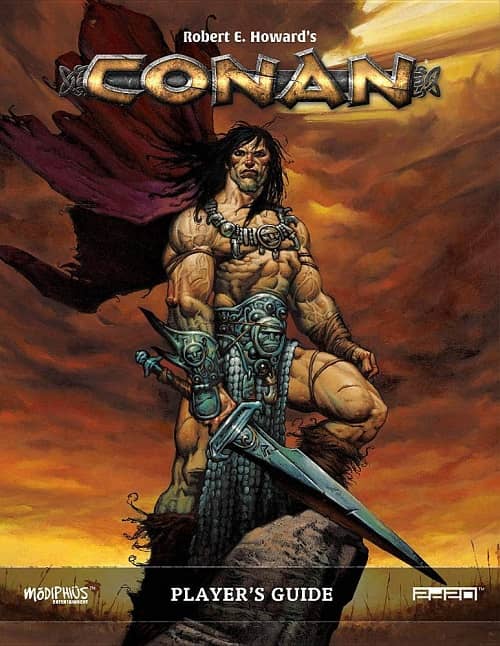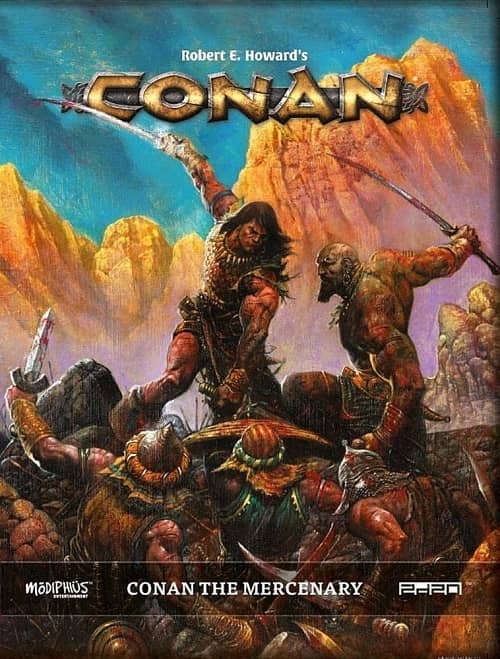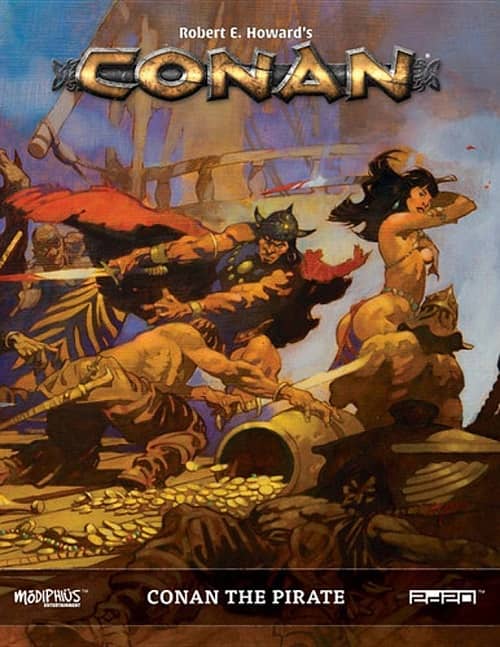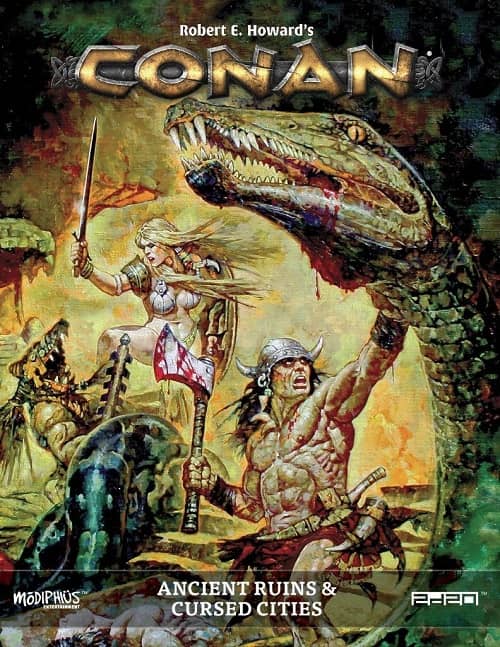A Report on Modiphius’s Robert E. Howard’s Conan: Adventures in an Age Undreamed Of — Part Two
This is the second article in my “explanation” of Conan 2d20. Last time I focused on 2d20’s core mechanic and on this game’s design philosophy insofar as it is an emulation of the “physics” and flavor of Robert E. Howard’s Conan fiction. This one will detail more aspects of gameplay, particularly player character components and action scenes.
Last article, I maintained that Conan 2d20 characters begin as powerful in mechanical ability (unless the alternative Shadows of the Past character generation is used). When I argue that this system is one of the better ones for Conan gaming, my rationale begins in this place. People who want to play a Conan version of Swords & Sorcery, I believe, don’t come to that desire by imagining operating a 1 Hit Die noob who is struggling to survive an attack of rats and who must run from most monsters. In contrast to this vision, Conan characters, though chronologically beginning their careers as young people, are formidable. Consequently, right away in the “campaign,” the GM is free to throw whatever she wants at the characters, just as Robert E. Howard challenged Conan with whatever he fancied, with whatever he believed would make an exciting story.
I realize I am thinking of Conan 2d20 in relation to the elephant (no, not that Elephant in the Tower, but that other elephant of gaming), and I’ll try to give it a rest after this. The comparison is in front of me because, as I explained last time, I have read many reports of people giving up on 2d20 because its rules are too far off from their familiar d20 expectations. My argument is that this is because Conan 2d20 is formulated, specifically, to emulate Robert E. Howard’s Conan. Whether it succeeds or not is very much still under discussion, and, elsewhere, that discussion goes on and on. But I believe that the Original Game, as awesome as it is, is built, out of its wargaming roots, as a melting pot or synthesis for all of fantasy literature. Conan 2d20 does Conan, just that, with all of its requisite limitations of “real” characters doing heroic things. The d20 iterations of Sword & Sorcery — even those “hacked” to better do Conan — still contain some difficult features, qualities inherent in and virtually impossible to remove from the system design. Chief among these is level-based advancement and, in most cases, the magic systems.
Okay, so I have beaten this to death. To reiterate, in Conan 2d20, new characters are not the equivalent of their Level 1 d20 counterparts but fully-fleshed characters with prodigious abilities and backgrounds. In fact, those abilities are so formidable that, in the wrong hands, and given full freedom of choice of character qualities, there is every possibility for power-gaming, or “min-maxing.” For this reason — but mostly because random generation is simply fun! — I encourage Conan gamers to make full use of the random tables provided for every aspect of character generation. This use is made all the easier if the player employs Modiphius’s online utility. In general, I advise players, if they absolutely have a particular concept in mind, to use all random generation tables outside of selecting Homeland and Archetype. Most go ahead and do all random generation, because it’s just so much fun, in this instance, “to roll and see what you get.”
Of course characters can “advance” through play, though they’ll always be heroic humans, not gods (for example, their Attributes never can be developed beyond 16). As with other games, Experience Points are awarded after every game session, and these can be spent to improve the character ad hoc. For character advancement, the process is pretty much what people call “point buy.” It employs different—and escalating—costs to raise (as noted) Attributes, Skill Expertise and Focus. They’re also used to accrue Skill Talents. This last feature provides the most PC variation and consequently the most difficult aspects that the player will have to remember during adventuring. I am told that the Skill Talent trees are inherited from modern adventure video games (the last video game I ever played was The Legend of Zelda: Ocarina of Time, so I’m taking everyone’s word on this).
I have emphasized that Conan 2d20 is emulationist (which I differentiate from simulationist). Common use makes the terms synonyms of each other, but I like to think of emulation as replicating the tone and quality of a particular work (usually of fiction), whereas I use simulation to be representative of what most people agree is reality, or, in other words, the way most people agree things really would happen.
Here are some examples of the two modes: my favorite Star Wars RPG is West End Games’s 1987 d6 version. There are, of course, appropriate emulations of the property also in Fantasy Flight’s current rules set, but my overwhelming and fond memories of WEG Star Wars is of Stormtroopers who are notoriously bad shots and of Blaster Bolts that can be Dodged. Most importantly, the game provided a narrative formula of what makes a good Star Wars “episode.”
In fact, the more I think about it now, the more in common Conan 2d20 has with WEG Star Wars, for both properties are rooted, ultimately, in action-packed pulp traditions. Some examples of simulationism, on the other hand, are those games that contain little discussion concerning particular narratives but a lot more about weights and measures and movement rates. I see that the three examples, off the top of my head, that I’m about to give are percentile systems. Moreover, they seem to be greatly informed by actual history, revealing the wargaming foundations of their progenitor.
The simulationist game with which I’m most familiar is Rolemaster (with its attack tables that reference particular weapons to particular armors, with its critical hit tables that dish out specific types of damage to nerves, bone, muscle and blood) but I also readily — and probably more accurately — include Harnmaster and Chivalry & Sorcery, probably because of how simulationist those systems are in regard to daily life in the actual Middle Ages.
So Conan 2d20 is emulative of Robert E. Howard’s fiction, and therefore the structure of an adventure is like the beats of a story rather than the painstaking exploration of a place or careful preparation and eventual execution of a journey, which is a simulation of “reality.” A Conan 2d20 adventure is divided into Scenes and, as with most fictions, and as with most games, the most attention is paid to Action Scenes.
If I just describe character creation and how to fight, that pretty much explicates the rules of any role playing game, so here we go. Attacking, in Conan 2d20, is done with a Skill Test. Opponents can elect to Parry, also done with a Skill Test, at which point the attacker’s Skill Test must be more successful than the defender’s. Incidentally, there is a cost to Parrying, in that, in most cases, the defender must pay 1 Doom to the GM for the Reaction. (It appears that just about every aspect of Conan 2d20 has been constructed with risk vs. reward principles in mind.) If an attack gets through, armor reduces the hit points (in this game called Vigor) taken to the target. If the target takes more than five points at any one time, or if the character is reduced to zero Vigor, then the target accrues a Wound, which raises the Difficulty of most Skill Tests by one. Each subsequent Wound increases this by one, and, yes, if a character’s Vigor is reduced to zero and that character takes more than five Vigor at once, then that character accrues two Wounds at once.
There are many ways of avoiding Wounds and damage, “character shields,” if you will, and some are fairly literal.
Defend
Before the opponent’s attack roll is resolved, a defender can elect to Parry or Dodge. In Melee, the defender must use the Parry Skill. If avoiding a Ranged attack, the defender must use Acrobatics. Defend is a Reaction that pays the GM 1 Doom.
Shields
In Conan 2d20, shields provide Cover (to be explained below), can be used to Parry, and can be used as bludgeoning weapons. They also can be sacrificed or sundered to ignore all damage from a single successful attack.
Armor
Armor can cover as many as all six areas of a character’s body. Its value subtracts damage to specific regions in the form of Soak. Like Shields, armor in a single location can be sacrificed to ignore all damage from a single hit to that area.
Fortune
If Wounds become unavoidable, a Fortune Point can be spent to ignore the increase in Difficulty that normally would be applied for taking one or more Wounds.
Hopefully you can see that so many character resources embolden the GM to throw whatever adversaries she likes at the PCs, for, if the players know their game, they should be able to take it! Of course, it’s acceptable to run, if all resources and options get spent! Character death is possible, but more likely incapacitation — this is a Conan story, after all, and the characters are our heroes.
I hope all these character shields likewise underscore the different quality of play I have been trying to reveal in Conan 2d20, in contrast to others. Perhaps the distinction is too subtle for me effectively to describe; perhaps, ideally, it is experienced through game play. Here’s a widely general and reductive attempt at an explanation, however: In traditional games, the player goal is to survive the challenges, and story happens while that happens. In Conan 2d20, it is a fairly foregone conclusion that the characters will survive; instead, the game is more in how the GM leverages the challenges and Doom mechanics to complicate the character’s lives. Both forms of play are in the interest of emerging story, but Conan characters seem to have a lot more… “plot armor,” if you will. In Conan 2d20, if a PC dies, you pretty much can truthfully claim that this is entirely the fault of the player. Again, it’s not that it can’t happen, it’s just that… how?
Damage
Damage is rolled with six-sided dice. Reading it takes some practice (but not as much as reading Star Wars or Genesys dice!). Damage is inflicted as follows: 1=1, 2=2, 3-4=0, 5-6=1+Effect. Weapons deal damage and certain Attributes contribute to damage. There actually are two types of damage that can be inflicted: physical (Vigor) and mental (Resolve). Many attacks have specific qualities that get triggered whenever an Effect is rolled (5-6) on the 6-sided damage dice.
This is an efficacious and elegant way of making combat pulpy and interesting. Through Effects, not only are weapons different because of the amount of damage they do but through specific features that are triggered 33.33% of the time. Other games might try to emulate this through critical hit tables. This one has it tied to the roll resolving the damage.
Combat dice are used for Cover, as well. Any time an attacked character is behind some sort of protective surface, including Shields, a number of Combat Dice are rolled (usually 2 or 4) and the results are deducted from the damage from the attack.
Zones
Also unlike traditional games, though the action in Conan is pulpy and tactical, combats are not detailed through use of a grid. Conan 2d20 uses Zones, and no, they are not specifically measured spaces. They can be big or little, long or short, wide or narrow. Usually they are defined by a feature, or a boundary of some sort, or a change in elevation, or a terrain. Let’s draft out an encounter in an inn: The common room might be one Zone or three. If three, perhaps the area around the hearth is one Zone; the rest, cluttered with tables and chairs, is another. Perhaps a bit of a lobby is a third. Private rooms on the other side of curtains or doors are more Zones. Stairs are another. The balcony they lead to is another. The bar area is yet another.
Zones are how the GM, with very little cognitive load, quickly sketches out an exciting and tactical landscape. There are many uses of Zones, but the most relevant to my brief overview here is how they relate to the use of Ranged weapons. And, before that, let me briefly touch on Melee combat.
Remember how, in my last article, I claimed that the default Difficulty is D1? To review, success, in most cases, is contingent on rolling #d20 and generating a Success by one of those rolling under a Target Number. This applies to Melee and Ranged combat, as well. However, in this context, a few considerations alter that premise.
In Melee combat, it is Reach. Longer weapons are more difficult to get by than shorter weapons. So, if a character with a Short Sword (Reach 2) is trying to attack an adversary with a Long Sword (Reach 3), the difference raises the Difficulty of the attack (in this case, from 1 to 2). Conversely, the opponent with the Long Sword must succeed at D1. In combat, it’s always at least D1 to hit.
In Ranged combat, the weapon has an ideal range in Zones away from the attacking character. If the attacker is firing at any target outside of that ideal Zone range, then the Difficulty is increased by one per difference in Zone increment. Zones are denoted as follows: Reach=engaged in Melee combat, Close=can get into Reach with a Free Action, Medium=one Zone away, Long=two Zones away, Extreme=three Zones away. For example, the ideal Range for a Shemite Long Bow is Long. If the character is shooting at a target in that Zone, the Difficulty of the test is D1. At Medium or Extreme Range it’s D2. At Close Range it’s D3. At Reach or beyond Extreme? Well, the character probably can’t even do it, but that’s up to the GM, I suppose.
I hope readers can intuit how well these rules emulate blow-by-blow, pulpy action without overwhelming the players with too much granularity or rules reference. In all honesty, in my games combat does move more slowly than I would like, but to speed things up or to abstract it any more, I believe, would mean to throw away many cool elements that are there for the purposes of emulating the fiction. I should add, moreover, that, in spite of what I say, combat can move faster than would be anticipated, and this is because there are three types of adversaries that PCs may face: Minions — can’t perform most “special” combat moves and dispatched with a single Wound, Toughened — follow the same rules as Minions but can take two Wounds, and Nemeses — possess all the tools and options that PCs do. Most combats would involve Mobs or Squads (yes, those words are capitalized because, in game terms, they mean something) of howling Minions often protecting or serving a powerful Nemesis and/or preventing the PCs from reaching some goal.
As I said, it’s unlikely that PCs ever are going to be threatened with death by combat. This is not an advisable way to raise tension in the game. Alternatively, I suggest that combat most often be used as an obstacle between the PCs and an intended goal. Again, think of the fiction, and you can see what I mean. Imagine Conan trying to escape an enchanted castle that’s going to melt with the dawn — and, at the very doors to freedom, he’s enwrapped within the coils of a massive serpent. Or he’s seeking to rescue a sacrifice upon the altar. A priest holds a knife above a woman’s bared breast; hordes of cultists, gnashing their teeth, stand in Conan’s way. As far as writing wisdom goes, the “pain” here that the GM is expected to leverage against the PCs is not so much against their persons as it is against their situations.
And that, dear friends, is adventure (and writing) gold.




Fascinating. Thank you, Mr. Dybing.
Mr. Dybing, I very much like your expansion of Ron Edwards’s “three-fold way” (Gamist, Narrativist, Simulationist) with the idea of “Emulationist”. Simulationist is meant to include genre simulation as well as reality verisimilitude, but I think that you are right to split the genre adherence off as Emulation and let Simulation point more at real-world re-creation.
I do not know if I would put Doom points in play for Parry and Dodge, which seem to be pretty standard parts of Conan fiction combat. But I have not played 2d20, so I do not have a feel for its points-pool “economy”. Please grace us with a session write-up or two and let us know how the shifting tides of story beats become realized in table-top action.
Eugene R., thank you for your recommendation.
I’ll have you know my reaction went from horror—that sounds like a lot of work!—to well, maybe I can try that.
Now I’m considering getting out some Monolith tiles and minis and running through a scenario. Thanks again.
[…] Review (Black Gate): This is the second article in my “explanation” of Conan 2d20. Last time I focused on 2d20’s […]